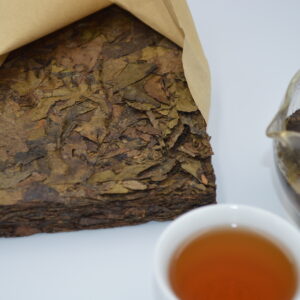Description
Collection item: natural aged Liubao tea
Origin: Liubao Town, Wuzhou, Guangxi Province
Harvest: 2007 winter leaves plucked on the First Frost’s Descent (Shuang Jiang 霜降)
Harvest: 2007 winter leaves plucked on the First Frost’s Descent (Shuang Jiang 霜降)
Direction:
use Zisha clay or porcelain teawares to brew 8-9 rounds at 100℃, tea:water 1:40
- dry tea is brick shape with suitable tightness, lustrous, reddish and yellowish brown color
- light purplish red color tea soup, clear and bright
- aged and mellow, pine smoky flavor and Jujube fragrances
- mellow and smooth, sweet and brisk tastes with sweet aftertaste, “aged rhyme” and betel nut palm tastes
- wet tea is dark brown
Introduction:
Lao Cha Po, Old Tea Lady, also known as Shuangjiang old tea lady, is made from old leaves of Liubao tea tree picked one week before and after Shuangjiang. Lao Cha Po is the honorific name of Liubao people for the old tea in the tea tree. Adding the word “Lao” in front of it does not refer to the old tea with a year, but refers to the old leaf. It is a product variety of Liubao tea in Guangxi.
Liubao tea is a kind of dark tea with unique quality characteristics, it is native and mainly produced in Liubao Town, Wuzhou, Guangxi province. Liubao tea started in the Tang and Song Dynasties and flourished in the Ming and Qing Dynasties. During the Jiaqing period of the Qing Dynasty (1796-1820), Liubao tea became one of the famous Chinese teas for its special betel nut flavor. Nowadays, the products are sold well in various provinces and cities in China, Hong Kong and Macao, Southeast Asia, Japan, Europe and America, etc. People who have drunk Liubao tea will have a special preference for its “Chinese red”. The Liubao tea industry believes that the cultural charm and national characteristics of “Chinese red” must be taken as the criterion to make Liubao tea embark on the road of rejuvenation.
The fresh leaves of Cangwu county group species, Guangxi large and medium-sized leaf species and their isolated and selected varieties are selected as raw materials and processed according to specific technology. Liubao tea is famous for its “red, thick, aged and mellow”. Dry tea shape is long and tight, the color of the soup is red, the aroma is thick, and the taste is mellow and delicious, it should be with pine smoke and betel nut palm flavor, wet leaf copper brown color.
Liubao tea is packed in bamboo basket, after steaming and kneading, the raw tea is packed in a basket and compacted. Then, it is placed in a dry place and stored in the air for several months. After natural fermentation, the tea is compacted and lumped, Liubao basket tea with unique mellow and stale flavor can be formed. The traditional bamboo basket packaging is conducive to the continuous transformation of the contents of tea during storage, which makes the taste mellow, the color of the soup deepened and the fragrance revealed. Liubao loose tea can be steamed and molded into Liubao cake tea, Liubao brick tea, Liubao bowl tea, etc.
Scientific experiments and tea tasting practice of Liubao tea lovers have proved that Liubao tea contains more lipolytic enzymes than other teas except for a variety of amino acids, vitamins and trace elements necessary for human body. Therefore, Liubao tea sets have stronger effect of decomposing greasy, reducing body fat compounds, cholesterol and triglycerides. Long term drinking can strengthen stomach, nourish spirit, lose weight and keep fit.



























